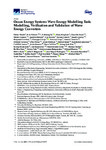Ocean Energy Systems Wave Energy Modelling Task: Modelling, Verification and Validation of Wave Energy Converters
| dc.contributor.author | Wendt, | |
| dc.contributor.author | Nielsen, | |
| dc.contributor.author | Yu, | |
| dc.contributor.author | Bingham, | |
| dc.contributor.author | Eskilsson, | |
| dc.contributor.author | Kramer, | |
| dc.contributor.author | Babarit, | |
| dc.contributor.author | Bunnik, | |
| dc.contributor.author | Costello, | |
| dc.contributor.author | Crowley, | |
| dc.contributor.author | Gendron, | |
| dc.contributor.author | Giorgi, | |
| dc.contributor.author | Giorgi, | |
| dc.contributor.author | Girardin, | |
| dc.contributor.author | Greaves, Deborah | |
| dc.contributor.author | Heras, | |
| dc.contributor.author | Hoffman, | |
| dc.contributor.author | Islam, | |
| dc.contributor.author | Jakobsen, | |
| dc.contributor.author | Janson, | |
| dc.contributor.author | Jansson, | |
| dc.contributor.author | Kim, | |
| dc.contributor.author | Kim, | |
| dc.contributor.author | Kim, | |
| dc.contributor.author | Kurniawan, | |
| dc.contributor.author | Leoni, | |
| dc.contributor.author | Mathai, | |
| dc.contributor.author | Nam, | |
| dc.contributor.author | Park, | |
| dc.contributor.author | Rajagopalan, | |
| dc.contributor.author | Ransley, E | |
| dc.contributor.author | Read, | |
| dc.contributor.author | Ringwood, | |
| dc.contributor.author | Rodrigues, | |
| dc.contributor.author | Rosenthal, | |
| dc.contributor.author | Roy, | |
| dc.contributor.author | Ruehl, | |
| dc.contributor.author | Schofield, | |
| dc.contributor.author | Sheng, | |
| dc.contributor.author | Shiri, | |
| dc.contributor.author | Thomas, | |
| dc.contributor.author | Touzon, | |
| dc.contributor.author | Yasutaka, | |
| dc.date.accessioned | 2019-11-08T13:01:05Z | |
| dc.date.available | 2019-11-08T13:01:05Z | |
| dc.date.issued | 2019-10-25 | |
| dc.identifier.issn | 2077-1312 | |
| dc.identifier.issn | 2077-1312 | |
| dc.identifier.other | 379 | |
| dc.identifier.uri | http://hdl.handle.net/10026.1/15126 | |
| dc.description.abstract |
<jats:p>The International Energy Agency Technology Collaboration Programme for Ocean Energy Systems (OES) initiated the OES Wave Energy Conversion Modelling Task, which focused on the verification and validation of numerical models for simulating wave energy converters (WECs). The long-term goal is to assess the accuracy of and establish confidence in the use of numerical models used in design as well as power performance assessment of WECs. To establish this confidence, the authors used different existing computational modelling tools to simulate given tasks to identify uncertainties related to simulation methodologies: (i) linear potential flow methods; (ii) weakly nonlinear Froude–Krylov methods; and (iii) fully nonlinear methods (fully nonlinear potential flow and Navier–Stokes models). This article summarizes the code-to-code task and code-to-experiment task that have been performed so far in this project, with a focus on investigating the impact of different levels of nonlinearities in the numerical models. Two different WECs were studied and simulated. The first was a heaving semi-submerged sphere, where free-decay tests and both regular and irregular wave cases were investigated in a code-to-code comparison. The second case was a heaving float corresponding to a physical model tested in a wave tank. We considered radiation, diffraction, and regular wave cases and compared quantities, such as the WEC motion, power output and hydrodynamic loading.</jats:p> | |
| dc.format.extent | 0-0 | |
| dc.language | en | |
| dc.language.iso | en | |
| dc.publisher | MDPI AG | |
| dc.subject | wave energy | |
| dc.subject | numerical modelling | |
| dc.subject | simulation | |
| dc.subject | boundary element method | |
| dc.subject | computational fluid dynamics | |
| dc.title | Ocean Energy Systems Wave Energy Modelling Task: Modelling, Verification and Validation of Wave Energy Converters | |
| dc.type | journal-article | |
| dc.type | Journal Article | |
| plymouth.author-url | https://www.webofscience.com/api/gateway?GWVersion=2&SrcApp=PARTNER_APP&SrcAuth=LinksAMR&KeyUT=WOS:000502261500002&DestLinkType=FullRecord&DestApp=ALL_WOS&UsrCustomerID=11bb513d99f797142bcfeffcc58ea008 | |
| plymouth.issue | 11 | |
| plymouth.volume | 7 | |
| plymouth.publication-status | Published online | |
| plymouth.journal | Journal of Marine Science and Engineering | |
| dc.identifier.doi | 10.3390/jmse7110379 | |
| plymouth.organisational-group | /Plymouth | |
| plymouth.organisational-group | /Plymouth/Faculty of Science and Engineering | |
| plymouth.organisational-group | /Plymouth/Faculty of Science and Engineering/School of Engineering, Computing and Mathematics | |
| plymouth.organisational-group | /Plymouth/PRIMaRE Publications | |
| plymouth.organisational-group | /Plymouth/REF 2021 Researchers by UoA | |
| plymouth.organisational-group | /Plymouth/REF 2021 Researchers by UoA/UoA12 Engineering | |
| plymouth.organisational-group | /Plymouth/Research Groups | |
| plymouth.organisational-group | /Plymouth/Research Groups/Marine Institute | |
| plymouth.organisational-group | /Plymouth/Users by role | |
| plymouth.organisational-group | /Plymouth/Users by role/Academics | |
| plymouth.organisational-group | /Plymouth/Users by role/Researchers in ResearchFish submission | |
| dcterms.dateAccepted | 2019-10-19 | |
| dc.rights.embargodate | 2019-11-26 | |
| dc.identifier.eissn | 2077-1312 | |
| dc.rights.embargoperiod | Not known | |
| rioxxterms.funder | EPSRC | |
| rioxxterms.identifier.project | Partnership for Research In Marine Renewable Energy (PRIMaRE) | |
| rioxxterms.versionofrecord | 10.3390/jmse7110379 | |
| rioxxterms.licenseref.uri | http://www.rioxx.net/licenses/all-rights-reserved | |
| rioxxterms.licenseref.startdate | 2019-10-25 | |
| rioxxterms.type | Journal Article/Review | |
| plymouth.funder | Partnership for Research In Marine Renewable Energy (PRIMaRE)::EPSRC | |
| plymouth.funder | Partnership for Research In Marine Renewable Energy (PRIMaRE)::EPSRC | |
| plymouth.funder | Partnership for Research In Marine Renewable Energy (PRIMaRE)::EPSRC |


